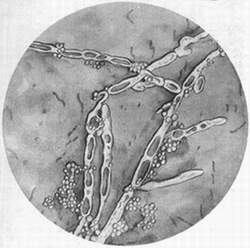| disease | Fungal Vulvitis |
| alias | Fungal Vulvilis |
When the body's resistance weakens or the antagonistic balance among microbial flora is disrupted, this bacterium can cause candidiasis. Conditions such as pregnancy, diabetes, vulvar injury or maceration, oral contraceptives, and immunosuppressive drugs like antibiotics can easily promote the occurrence of vulvovaginal candidiasis. During pregnancy, changes in cellular immunity or glucose metabolism, or the abundant glycogen storage in vaginal epithelium, favor the development of vulvovaginitis. Diabetic patients, with high sugar content in their blood and tissues, are also prone to Candida infections. Oral corticosteroids can reduce the body's immunity or alter glucose metabolism. Long-term use of antibiotics may suppress other bacteria in the intestines or skin, leading to the overgrowth of Candida.
bubble_chart Etiology
Fungal vulvitis is an inflammation of the vulva caused by a yeast-like fungus. The most common pathogen is Candida albicans. (Photo 1) It often coexists with fungal vaginitis and is referred to as fungal vulvovaginitis.

Photo 1 Microscopic view of Candida albicans (vaginal smear)
bubble_chart Clinical Manifestations
The clinical symptoms of fungal vulvitis include cutaneous pruritus, burning sensation, and painful urination (complicated by urethritis), with many women complaining of dyspareunia. The vulvar area is often red and edematous. Epidermal changes vary widely: very superficial blisters or papules may appear in clusters; eczema-like erosions may form, localized to the vulva or spreading to the perineum, perianal area, and genitocrural folds, extending to the inner thighs, closely resembling acute or subacute eczema. The mucous membranes between the labia and near the clitoris thicken, and the contacting skin surfaces become erythematous and eroded. In some cases, tiny white pustules may develop, and severe cases can lead to ulcers, causing pain in the affected area and inflammation of the local lymph nodes.
bubble_chart DiagnosisSevere and intractable vulvar cutaneous pruritus should first consider the possibility of fungal infection. Diagnosis can be confirmed through direct smear examination and culture of local secretions, as fungal hyphae, branches, and spores are easily visible under the microscope. Candida albicans appears oval-shaped, Gram-negative, though staining is often uneven, measuring about 3–5 μm (several times larger than staphylococci). It frequently produces long buds that do not detach (spores), resembling hyphae but not true hyphae, hence termed pseudomycelia.
bubble_chart Treatment Measures
Clean the vulva or take a sitz bath with a 1:5000 potassium permanganate solution, then apply 2% Chinese Gentian Violet solution topically. In recent years, the use of nystatin has shown significant effects. Dosage: Insert a 100,000 U vaginal suppository deep into the vagina twice daily (morning and evening) for 5 days. Clean the vulva and apply nystatin ointment (100,000 U/g) topically 2-3 times daily. To promote vaginal epithelial regeneration after treatment, a small amount of estrogen (diethylstilbestrol 0.25–0.5 mg/day for 3–5 days) can be used. For recurrent cases, consider gastrointestinal carriage of the fungus and concurrently administer oral nystatin at 500,000 U per dose, four times daily. So far, no nystatin-resistant Candida albicans strains have been identified. Recurrences are often due to insufficient dosage, incomplete treatment, failure to strictly abstain from intercourse during treatment, or untreated male partners. Additionally, recent use of antifungal agents such as ketoconazole, trichomycin, and clotrimazole has proven effective. For details, refer to fungal vaginitis.





